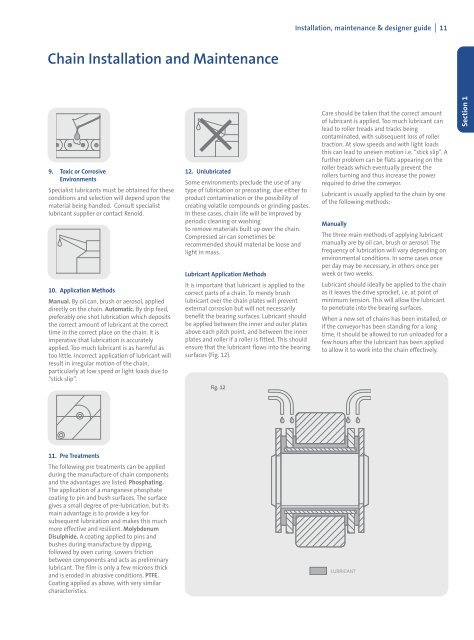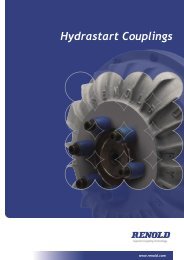Conveyor chain
Conveyor chain
Conveyor chain
You also want an ePaper? Increase the reach of your titles
YUMPU automatically turns print PDFs into web optimized ePapers that Google loves.
Chain Installation and Maintenance<br />
9. Toxic or Corrosive<br />
Environments<br />
Specialist lubricants must be obtained for these<br />
conditions and selection will depend upon the<br />
material being handled. Consult specialist<br />
lubricant supplier or contact Renold.<br />
10. Application Methods<br />
Manual. By oil can, brush or aerosol, applied<br />
directly on the <strong>chain</strong>. Automatic. By drip feed,<br />
preferably one shot lubrication which deposits<br />
the correct amount of lubricant at the correct<br />
time in the correct place on the <strong>chain</strong>. It is<br />
imperative that lubrication is accurately<br />
applied. Too much lubricant is as harmful as<br />
too little. Incorrect application of lubricant will<br />
result in irregular motion of the <strong>chain</strong>,<br />
particularly at low speed or light loads due to<br />
“stick slip”.<br />
11. Pre Treatments<br />
The following pre treatments can be applied<br />
during the manufacture of <strong>chain</strong> components<br />
and the advantages are listed. Phosphating.<br />
The application of a manganese phosphate<br />
coating to pin and bush surfaces. The surface<br />
gives a small degree of pre-lubrication, but its<br />
main advantage is to provide a key for<br />
subsequent lubrication and makes this much<br />
more effective and resilient. Molybdenum<br />
Disulphide. A coating applied to pins and<br />
bushes during manufacture by dipping,<br />
followed by oven curing. Lowers friction<br />
between components and acts as preliminary<br />
lubricant. The film is only a few microns thick<br />
and is eroded in abrasive conditions. PTFE.<br />
Coating applied as above, with very similar<br />
characteristics.<br />
12. Unlubricated<br />
Some environments preclude the use of any<br />
type of lubrication or precoating, due either to<br />
product contamination or the possibility of<br />
creating volatile compounds or grinding pastes.<br />
In these cases, <strong>chain</strong> life will be improved by<br />
periodic cleaning or washing<br />
to remove materials built up over the <strong>chain</strong>.<br />
Compressed air can sometimes be<br />
recommended should material be loose and<br />
light in mass.<br />
Lubricant Application Methods<br />
It is important that lubricant is applied to the<br />
correct parts of a <strong>chain</strong>. To merely brush<br />
lubricant over the <strong>chain</strong> plates will prevent<br />
external corrosion but will not necessarily<br />
benefit the bearing surfaces. Lubricant should<br />
be applied between the inner and outer plates<br />
above each pitch point, and between the inner<br />
plates and roller if a roller is fitted. This should<br />
ensure that the lubricant flows into the bearing<br />
surfaces (Fig. 12).<br />
Fig. 12<br />
Installation, maintenance & designer guide I 11<br />
Care should be taken that the correct amount<br />
of lubricant is applied. Too much lubricant can<br />
lead to roller treads and tracks being<br />
contaminated, with subsequent loss of roller<br />
traction. At slow speeds and with light loads<br />
this can lead to uneven motion i.e. “stick slip”. A<br />
further problem can be flats appearing on the<br />
roller treads which eventually prevent the<br />
rollers turning and thus increase the power<br />
required to drive the conveyor.<br />
Lubricant is usually applied to the <strong>chain</strong> by one<br />
of the following methods:-<br />
Manually<br />
The three main methods of applying lubricant<br />
manually are by oil can, brush or aerosol. The<br />
frequency of lubrication will vary depending on<br />
environmental conditions. In some cases once<br />
per day may be necessary, in others once per<br />
week or two weeks.<br />
Lubricant should ideally be applied to the <strong>chain</strong><br />
as it leaves the drive sprocket, i.e. at point of<br />
minimum tension. This will allow the lubricant<br />
to penetrate into the bearing surfaces.<br />
When a new set of <strong>chain</strong>s has been installed, or<br />
if the conveyor has been standing for a long<br />
time, it should be allowed to run unloaded for a<br />
few hours after the lubricant has been applied<br />
to allow it to work into the <strong>chain</strong> effectively.<br />
Section 1




